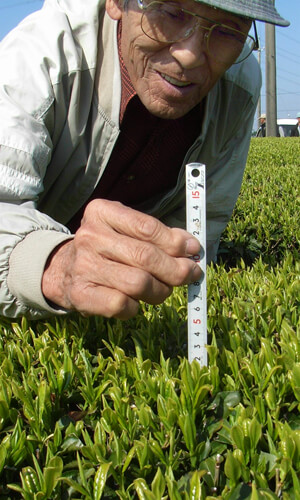Masuda Yoshio
To ensure the best quality and value, we import our teas directly from the
countries in which they are grown, working closely with the farmers who tender
them.
Our Roots Campaign connects our customers with the rich stories and the farmers behind some of our most popular teas.
Our Roots Campaign connects our customers with the rich stories and the farmers behind some of our most popular teas.
Makinohara, Japan

How long have you been growing tea?
“I was born and raised in Makihohara region, the Japan's No.1 green tea production area. I have been involved with green tea production for the past 38 years.”
What got you started in the Tea industry?
“My grandfather started green tea farming and production, and my father took over it and then myself. I am the third generation. Masudaen as a company has been doing green tea business for almost a century now.”
Can you describe a typical day out in the field. How many hours would that be?
“I walk around the green tea fields at 6AM every morning, and checking green tea bushes. During harvest season, I harvest tea leaves with young staff, and do the processing also. Freshness is the most crucial thing for green tea. So, our factory is moving 24 hours a day during the harvest season. The harvested tea leaves becomes green tea (finished products) the next day. ”
What is your favorite part of growing tea? What inspires you to keep going?
“Japan has distinct 4 seasons. During the winter, all the plants rest. In spring time, March and April, all the trees' buds and flowers start coming out. During this season, green tea fields turn its color into yellowish green. We are moved by the scene and the long waited first harvest of green tea.”
Conversely, what is the hardest part of your job?
“The battle with the nature is the hardest thing. It may rain too much or too little. It may be too hot or too cold. Growing plants (green tea fields) is greatly affected by weather and climate.”
How has tea farming changed over the years?
“We are facing an issue of rise of price in costs, such as fertilizer and fuel for machineries. We try to use larger harvesting machines to cut the cost of labor. Part of Masudaen's green tea estates is certitied by JAS Organic and NOP (USDA). Thus we can produce organic tea to accommodate organic needs.”
What do you think makes your tea more unique or better than others?
“We grow or take care of even the soil. And we do the whole process by ourselves, from start to finish. Thus we can assure you with safe green tea with all the history of production. We can trace back where and when a certain lot of tea was produced.”
What makes the difference between a successful and unsuccessful harvest?
“About 50% of it depends on green tea leaves in the fields, in my opinion. And 30% is the manufacturing process, and 20% is the refining process such as blending and roasting.”
Do you exchange growing secrets with other local farmers?
“Masudaen has 15 neighboring contract farmers who cooperate with us. We give certain information and lectures to direct growing good tea leaves. We also hold a study with them once every 2 months, and we study and research as to growing better quality tea.”
Are there any tips you can give on how to best brew your tea?
“Green tea's taste differs by the temperature of hot water you pour in. Basically, the better tea, the lower temperature hot water you pour in. First, you must boil water and then cool it off. For high quality Sencha, approximately 70C (158F). Mid quality Sencha, 80C (176F). And lower grade green tea, 90C (194F) are suitable. For Genmaicha, 80 to 90C are suitable.”
What is your favorite tea to drink and why?
“Fukamushi Sencha (Deep Steamed Sencha). The water color is deep green and its taste is rich. During the production, we put twice as longer steam as regular Sencha. Therefore, the tea leaves become broken and it may look like lower quality tea, to those who are used to seeing long tea leaves. But green tea is not something you look and enjoy; green tea is for drinking. It has less bitterness and has rich taste.”
If you had any advice to give western tea drinkers, what would it be?
“As green tea has different kinds, Sencha has different kinds, such as regular Sencha, Deep-steamed Sencha. Also there are Gyokuro, Tamaryokucha, Kukicha, Genmaicha, and so on. Japanese tea is all natural and healthy. It is important to find your favorite tea and drink it every day. That is the secret of applying green tea's health effect. Especially, Sencha has much Catechin which prevents cancer and common cold.”
What does this project & contribution mean to you?
“I think this is a great thing. I would be so glad if readers of this article would become great fans of Japanese green tea and start drinking green tea.”
view tea >>